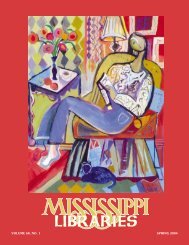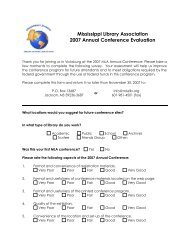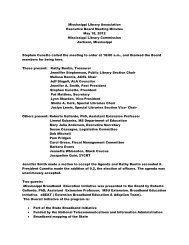Full Text (PDF) - Mississippi Library Association
Full Text (PDF) - Mississippi Library Association
Full Text (PDF) - Mississippi Library Association
Create successful ePaper yourself
Turn your PDF publications into a flip-book with our unique Google optimized e-Paper software.
Page 42 Vol. 75, No. 1, Spring 2012 <strong>Mississippi</strong> Libraries<br />
attacks from the Ku Klux Klan).<br />
Beneficial to researchers are the<br />
explanatory notes and bibliographic<br />
sources at the end of each essay. Also<br />
included in the book are fifteen reprinted<br />
photographs and illustrations, brief biographical<br />
information about the twenty contributors,<br />
a selected bibliography, and an<br />
index. A map in the front of the book highlights<br />
the <strong>Mississippi</strong> counties that are focal<br />
points in the text.<br />
The editors, who are university professors,<br />
contributed essays to the book. Elizabeth<br />
Anne Payne is a professor of history at<br />
the University of <strong>Mississippi</strong>; Martha H.<br />
Swain is Cornaro Professor of History<br />
Emerita at Texas Woman’s University; and<br />
Marjorie Julian Spruill is a professor of history<br />
at the University of South Carolina.<br />
This book is recommended for academic<br />
and public libraries building collections<br />
of southern American history. It<br />
could also serve as an informative text for<br />
a classroom history assignment.<br />
Lila Jefferson, Acquisitions Librarian, University<br />
of Louisiana at Monroe<br />
— ◆ —<br />
Span, Christopher M. From Cotton<br />
Field to Schoolhouse: African American<br />
Education in <strong>Mississippi</strong>, 1862-1875.<br />
Chapel Hill: University of North Carolina<br />
Press, 2009. 264 pp. $35.00 (hardcover)<br />
From Cotton Field to Schoolhouse is<br />
centered on the debate over the control of<br />
and purpose of black schools. The book is<br />
also a thorough inspection of the political<br />
landscape and the policies of racial education<br />
in <strong>Mississippi</strong>.<br />
The main argument is whether schools<br />
for freed slaves should establish those<br />
freedmen as citizens, equip them for freedom<br />
but as inferior manual workers, or<br />
devise another, altogether different, end<br />
result. The freed slaves perceived that<br />
schools they created for themselves would<br />
allow them to become independent, politically<br />
legitimate, and have some societal<br />
and economic flexibility. However, most<br />
northerners, who were helping the freed<br />
slaves, saw the freed people’s perception<br />
of their educated selves as impractical. The<br />
northerners fully expected the freed slaves<br />
to continue working, albeit under contract,<br />
for the very persons who had enslaved<br />
them. At the same time, the vast majority<br />
of white <strong>Mississippi</strong>ans argued against any<br />
educational opportunities for former<br />
slaves. Limiting his work to <strong>Mississippi</strong><br />
from 1862 to the end of Reconstruction in<br />
1875, Span proves that the freed slaves’<br />
desire for an all-inclusive public education<br />
system plays a critical role in the political<br />
landscape and the policies of racial education<br />
in <strong>Mississippi</strong> during that time. It<br />
becomes abundantly clear that his purpose<br />
for writing From Cotton Field to Schoolhouse<br />
is for the reader to understand the<br />
significance of knowledge and literacy to<br />
the slave community, and how those who<br />
were once slaves became knowledgeable.<br />
Others have chronicled the trials of education<br />
in the South during Reconstruction,<br />
but Span’s work is seemingly the first compelling<br />
book to portray the drama of former<br />
<strong>Mississippi</strong> slaves’ quest for a public<br />
education. Although predicated upon<br />
astounding archival research, Span’s book<br />
can arguably serve as an ideal for those<br />
southern states who wish to chronicle<br />
black educational efforts. Therefore, those<br />
interested in African American history,<br />
Southern history, Reconstruction, and<br />
African American educational history will<br />
find this title most informative. From Cotton<br />
Field to Schoolhouse would be a wise<br />
purchase for any public or academic<br />
library.<br />
Mantra Henderson, interim director,<br />
James H. White <strong>Library</strong>, <strong>Mississippi</strong> Valley<br />
State University<br />
— ◆ —<br />
Trethewey, Natasha. Beyond Katrina: A<br />
Meditation on the <strong>Mississippi</strong> Gulf Coast.<br />
Athens: The University of Georgia Press,<br />
2010. 127 pp. $22.95 (hardcover)<br />
“...I ask [audience members] what they<br />
remember when they hear the words Hurricane<br />
Katrina. Almost all of them say,<br />
‘New Orleans,’ recalling the footage<br />
beginning the day after landfall, when the<br />
levees broke. Almost never does anyone<br />
answer ‘the <strong>Mississippi</strong> Gulf Coast.’”<br />
Pulitzer Prize-winning poet Natasha<br />
Trethewey has written her own answer to<br />
this question in an exploration of her family<br />
history, family relationships, and her personal<br />
history. Just as residents of the Gulf<br />
Coast returned after the storm to find what<br />
was left of their homes, their belongings,<br />
and their communities, Trethewey<br />
metaphorically digs through the debris to<br />
see what Hurricane Katrina has left behind<br />
and to find what was unearthed by the<br />
wind and flood waters.<br />
In a manner reminiscent of Spike Lee’s<br />
documentary film, When the Levees<br />
Broke: A Requiem in Four Acts,<br />
Trethewey has divided her journey by time<br />
and place. Poetry and family photographs<br />
are interspersed with the narrative adding a<br />
deeply personal dimension that will leave<br />
even those who have grown up on the<br />
coast feeling like they are walking new<br />
paths on familiar shores.<br />
Throughout the book we travel to the<br />
current Gulf Coast and then all the way<br />
back to Hurricane Camille. Trethewey, like<br />
Spike Lee, finds that much of the devastation<br />
to the African American community<br />
(and to the coast itself) began a long time<br />
before the hurricane. The historical, political,<br />
and industrial landscape shows a slow<br />
erosion of community, residential areas,<br />
and even marine life and wetlands starting<br />
as far back as the 1920s from casinos and<br />
increasing commercial development.<br />
The reader meets members of<br />
Trethewey’s family, learning the most<br />
about her brother Joe, but will find in the<br />
end that all along they have been looking<br />
at Trethewey herself through different lenses.<br />
The motivation, the true drive for writing<br />
this book is one of self-discovery; in<br />
the individual, we find the story of many.<br />
“... [T]he destroyed public library is me as<br />
a girl...the empty debris-strewn downtown<br />
Gulfport is me...” The landmarks in the<br />
place where the author grew up have














